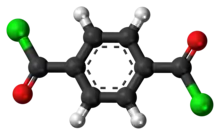Terephthaloyl chloride
Terephthaloyl chloride (TCL, 1,4-benzenedicarbonyl chloride) is the acid chloride of terephthalic acid and is one of two monomers used to make Kevlar(R), the other being p-phenylenediamine.
 | |
 | |
| Names | |
|---|---|
| Preferred IUPAC name
Benzene-1,4-dicarbonyl dichloride[1] | |
| Other names
Terephthaloyl dichloride[1] 1,4-Benzenedicarbonyl chloride Benzene-1,4-dicarbonyl chloride Terephthalic acid dichloride Terephthaloyl dichloride p-Phthalyl chloride TCL | |
| Identifiers | |
3D model (JSmol) |
|
| ChemSpider | |
| ECHA InfoCard | 100.002.572 |
PubChem CID |
|
| UNII | |
CompTox Dashboard (EPA) |
|
| |
| |
| Properties | |
| C8H4Cl2O2 | |
| Molar mass | 203.02 g/mol |
| Density | 1.34 g/cm3 |
| Melting point | 81.5 to 83 °C (178.7 to 181.4 °F; 354.6 to 356.1 K) |
| Boiling point | 265 °C (509 °F; 538 K) |
Except where otherwise noted, data are given for materials in their standard state (at 25 °C [77 °F], 100 kPa). | |
| Infobox references | |
TCL is used as a key component in performance polymers and aramid fibers, where it imparts flame resistance, chemical resistance, temperature stability, light weight, and very high strength. TCL is also an effective water scavenger, used to stabilize isocyanates and urethane prepolymers.
Properties
TCL is a white crystalline solid at room temperature, soluble in common organic solvents. Its melting point is 81.5-83 °C, its boiling point is 265 °C. It is corrosive.
Preparation
Terephthalic acid dichloride can be obtained by chlorination of dimethyl terephthalate.[2]
Use
TCL is used for making various copolymers and aramid polymers such as Heracron, Twaron and Kevlar(R):

References
- Nomenclature of Organic Chemistry : IUPAC Recommendations and Preferred Names 2013 (Blue Book). Cambridge: The Royal Society of Chemistry. 2014. p. 797. doi:10.1039/9781849733069-FP001. ISBN 978-0-85404-182-4.
- EP 0095698, Walter Böckmann, Friedrich Brühne, Karl-August Lipper, "Verfahren zur Herstellung von Terephthalsäure- und Isophthalsäuredichlorid"